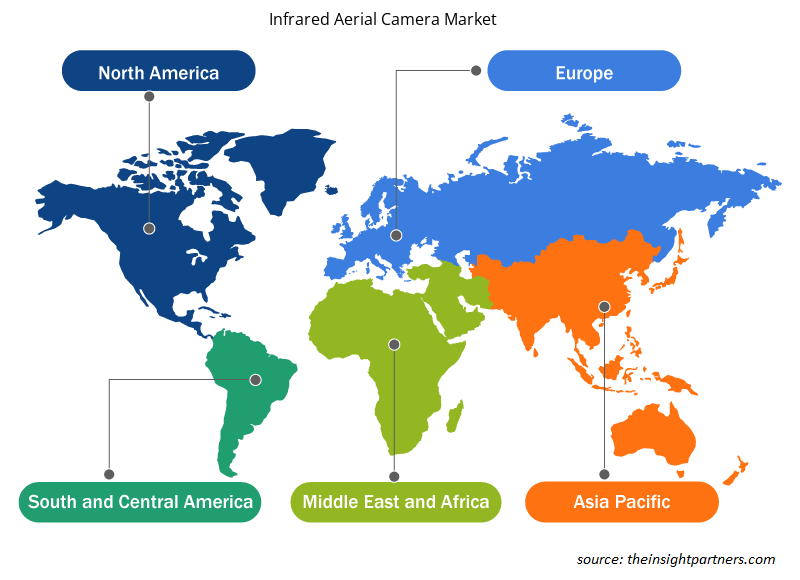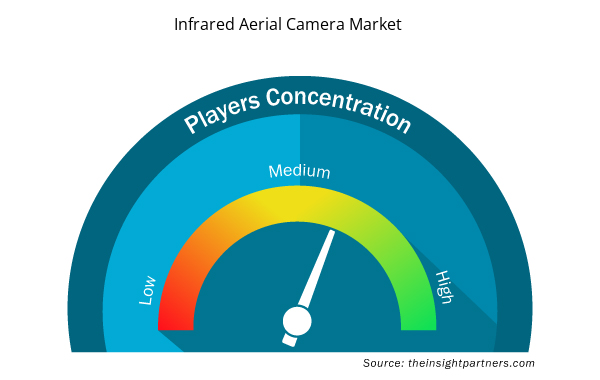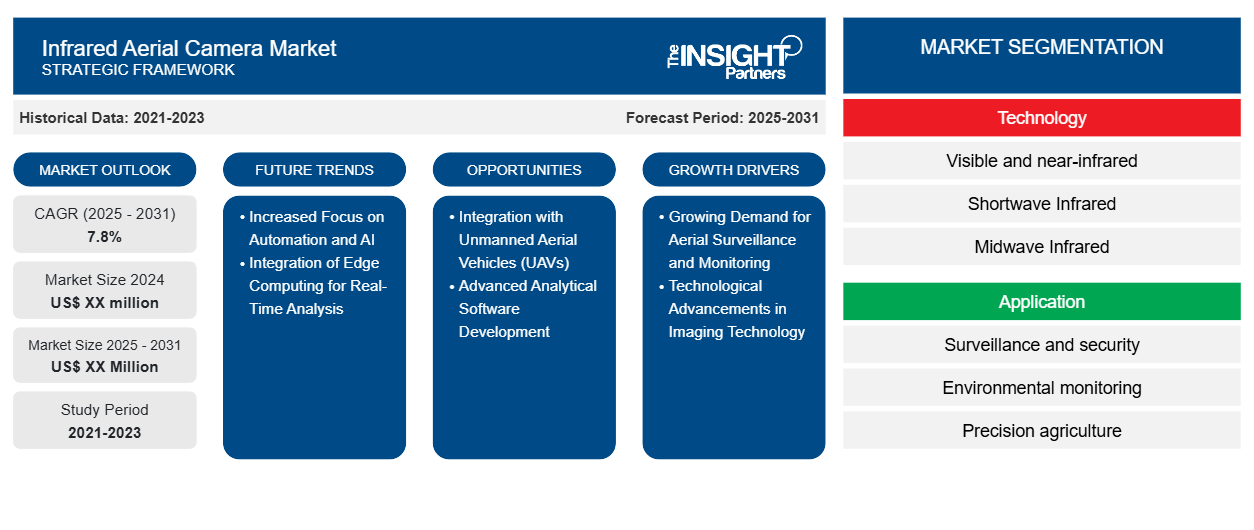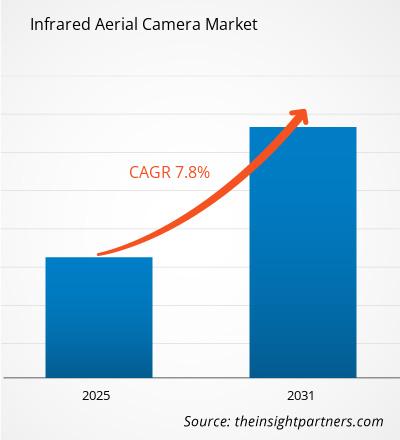Der Markt für Infrarot-Luftbildkameras wird voraussichtlich von 2023 bis 2031 eine durchschnittliche jährliche Wachstumsrate (CAGR) von 7,8 % verzeichnen, wobei die Marktgröße von XX Millionen US-Dollar im Jahr 2023 auf XX Millionen US-Dollar im Jahr 2031 wachsen wird.
Der Bericht ist segmentiert nach Technologie (sichtbares und nahes Infrarot (VNIR), kurzwelliges Infrarot (SWIR), mittelwelliges Infrarot (MWIR), langwelliges Infrarot (LWIR)); Anwendung (Überwachung und Sicherheit, Umweltüberwachung, Präzisionslandwirtschaft, Infrastrukturinspektion); Geografie (Nordamerika, Europa, Asien-Pazifik, Naher Osten und Afrika, Süd- und Mittelamerika).
Die globale Analyse ist weiter auf regionaler Ebene und nach wichtigen Ländern aufgeschlüsselt. Der Bericht bietet den Wert in USD für die oben genannte Analyse und Segmente
Zweck des Berichts
Der Bericht „Infrarot-Luftbildkamera-Markt“ von The Insight Partners zielt darauf ab, die aktuelle Situation und das zukünftige Wachstum sowie die wichtigsten treibenden Faktoren, Herausforderungen und Chancen zu beschreiben. Dies wird verschiedenen Geschäftspartnern Einblicke geben, wie zum Beispiel:
- Technologieanbieter/-hersteller: Um die sich entwickelnde Marktdynamik zu verstehen und die potenziellen Wachstumschancen zu kennen, damit sie fundierte strategische Entscheidungen treffen können.
- Investoren: Durchführung einer umfassenden Trendanalyse hinsichtlich der Marktwachstumsrate, der finanziellen Marktprognosen und der Chancen entlang der Wertschöpfungskette.
- Regulierungsbehörden: Zur Regulierung von Richtlinien und Überwachungsaktivitäten auf dem Markt mit dem Ziel, Missbrauch zu minimieren, das Vertrauen der Anleger zu bewahren und die Integrität und Stabilität des Marktes aufrechtzuerhalten.
Infrarot-Luftbildkamera Marktsegmentierung
Technologie
- Sichtbares und nahes Infrarot
- Kurzwelliges Infrarot
- Mittelwellen-Infrarot
- Langwelliges Infrarot
Anwendung
- Überwachung und Sicherheit
- Umweltüberwachung
- Präzisionslandwirtschaft
- Inspektion der Infrastruktur
Passen Sie diesen Bericht Ihren Anforderungen an
Sie erhalten kostenlos individuelle Anpassungen an jedem Bericht, einschließlich Teilen dieses Berichts oder einer Analyse auf Länderebene, eines Excel-Datenpakets sowie tolle Angebote und Rabatte für Start-ups und Universitäten.
- Holen Sie sich die wichtigsten Markttrends aus diesem Bericht.Dieses KOSTENLOSE Beispiel umfasst eine Datenanalyse von Markttrends bis hin zu Schätzungen und Prognosen.
Wachstumstreiber auf dem Markt für Infrarot-Luftbildkameras
- Wachsende Nachfrage nach Luftüberwachung und -monitoring: Aufgrund des steigenden Bedarfs an Luftüberwachung in der Landwirtschaft, der Umweltüberwachung sowie der Sicherung von städtischen und ländlichen Gebieten ist der Markt für Infrarot-Luftbildkameras stark motiviert. Die Kameras erweisen sich als entscheidend, wenn es darum geht, wertvolle Informationen über den Zustand von Nutzpflanzen zu liefern, Waldbrände zu erkennen und die Sicherheit in Städten zu erhöhen. Durch die Bereitstellung von Wärmebildern können Infrarotkamerainstallationen den Raum in einer Umgebung mit eingeschränkter Sicht effektiv überwachen, was sie für viele Anwendungen unverzichtbar macht.
- Technologische Fortschritte in der Bildgebungstechnologie: Der Markt für Infrarot-Luftbildkameras wird aufgrund der kontinuierlichen Weiterentwicklung technologischer Faktoren in der Infrarot-Bildgebungstechnologie wachsen. Eine verbesserte Sensorempfindlichkeit, eine bessere Bildauflösung und bessere Ergebnisse bei der Datenverarbeitung sind alles Faktoren, die dazu führen, dass Infrarotkameras effizienter und vielseitiger werden. Mit der Weiterentwicklung der Technologie sinken daher die Kosten für Infrarotkameras weiter, was sowohl großen Unternehmen als auch Kleinbauern zugutekommt.
Zukünftige Trends auf dem Markt für Infrarot-Luftbildkameras
- Verstärkter Fokus auf Automatisierung und KI: Im Hinblick auf die Datenanalysetrends von Infrarot-Luftbildkameras liegt der Fokus verstärkt auf Automatisierung und KI. Automatisierte Systeme verarbeiten schnell riesige Mengen an Wärmebilddaten und machen sichtbare Dinge sichtbar, die für das menschliche Auge unsichtbar sind: Muster und Anomalien. Dieser Entwicklungstrend ist besonders für den Agrarsektor relevant, wo KI hilft, Managementpraktiken auf der Grundlage von Erkenntnissen aus Wärmedaten zu optimieren.
- Integration von Edge Computing für Echtzeitanalysen: In Zukunft werden Infrarot-Luftbildkameras verstärkt Edge Computing integrieren, was eine Echtzeit-Datenverarbeitung direkt auf dem Gerät ermöglicht. Dies wird die Geschwindigkeit und Effizienz der Wärmebildanalyse verbessern und sofortige Erkenntnisse für Branchen wie Landwirtschaft, Energie und Infrastruktur liefern. Mit KI-gesteuerten Algorithmen am Rand werden Entscheidungen schneller und präziser getroffen, was die Betriebseffizienz und Reaktionsfähigkeit verbessert.
Marktchancen für Infrarot-Luftbildkameras
- Integration mit unbemannten Luftfahrzeugen (UAVs): Die Integration von Infrarot-Luftbildkameras in UAVs oder Drohnen ist eine neue große Chance, die es zu nutzen gilt. Wärmebilddrohnen ermöglichen das schnelle und effiziente Scannen großer Flächen und sind daher besonders nützlich für Anwendungen wie Suche und Rettung, Wildtierüberwachung und die Inspektion von Infrastruktur. Da der Drohnenmarkt weiter wächst, könnte auch der Bedarf an kompatiblen Infrarotkameras steigen, was neue Wege für Innovation und Zusammenarbeit eröffnet.
- Entwicklung fortschrittlicher Analysesoftware: Unternehmen haben die Möglichkeit, fortschrittliche Software zur Ergänzung von Infrarot-Luftbildkameras zu entwickeln. Hersteller können Tools zur Datenanalyse und -visualisierung anbieten, um den Wert ihrer Bildgebungsprodukte zu steigern. Die Software kann eine bessere Interpretation von Wärmedaten ermöglichen, um die Qualität der Entscheidungsfindung und der Ergebnisse in Anwendungen wie Landwirtschaft und Umweltüberwachung zu verbessern.
Regionale Einblicke in den Markt für Infrarot-Luftbildkameras
Die regionalen Trends und Faktoren, die den Markt für Infrarot-Luftbildkameras im Prognosezeitraum beeinflussen, wurden von den Analysten von Insight Partners ausführlich erläutert. In diesem Abschnitt werden auch die Marktsegmente und die Geografie von Infrarot-Luftbildkameras in Nordamerika, Europa, im asiatisch-pazifischen Raum, im Nahen Osten und Afrika sowie in Süd- und Mittelamerika erörtert.

- Erhalten Sie regionalspezifische Daten zum Markt für Infrarot-Luftbildkameras
Umfang des Marktberichts über Infrarot-Luftbildkameras
| Berichtsattribut | Details |
|---|---|
| Marktgröße im Jahr 2023 | XX Millionen US-Dollar |
| Marktgröße bis 2031 | XX Millionen US-Dollar |
| Globale CAGR (2023 - 2031) | 7,8 % |
| Historische Daten | 2021-2022 |
| Prognosezeitraum | 2024–2031 |
| Abgedeckte Segmente | Nach Technologie
|
| Abgedeckte Regionen und Länder | Nordamerika
|
| Marktführer und wichtige Unternehmensprofile |
|
Marktteilnehmerdichte für Infrarot-Luftbildkameras: Auswirkungen auf die Geschäftsdynamik verstehen
Der Markt für Infrarot-Luftbildkameras wächst rasant. Dies wird durch die steigende Nachfrage der Endnutzer aufgrund von Faktoren wie sich entwickelnden Verbraucherpräferenzen, technologischen Fortschritten und einem größeren Bewusstsein für die Vorteile des Produkts vorangetrieben. Mit der steigenden Nachfrage erweitern Unternehmen ihr Angebot, entwickeln Innovationen, um die Bedürfnisse der Verbraucher zu erfüllen, und nutzen neue Trends, was das Marktwachstum weiter ankurbelt.
Die Marktteilnehmerdichte bezieht sich auf die Verteilung von Firmen oder Unternehmen, die in einem bestimmten Markt oder einer bestimmten Branche tätig sind. Sie gibt an, wie viele Wettbewerber (Marktteilnehmer) in einem bestimmten Marktraum im Verhältnis zu seiner Größe oder seinem gesamten Marktwert präsent sind.
Die wichtigsten auf dem Markt für Infrarot-Luftbildkameras tätigen Unternehmen sind:
- Allied Vision Technologies GmbH
- Axsys Technologien
- FLIR Systems, Inc.
- General Dynamics Mission Systems, Inc.
- Infrarot-Kameras Inc.
Haftungsausschluss : Die oben aufgeführten Unternehmen sind nicht in einer bestimmten Reihenfolge aufgeführt.

- Überblick über die wichtigsten Akteure auf dem Markt für Infrarot-Luftbildkameras
Wichtige Verkaufsargumente
- Umfassende Abdeckung: Der Bericht deckt die Analyse von Produkten, Dienstleistungen, Typen und Endbenutzern des Infrarot-Luftkamera-Marktes umfassend ab und bietet einen ganzheitlichen Überblick.
- Expertenanalyse: Der Bericht basiert auf dem umfassenden Verständnis von Branchenexperten und Analysten.
- Aktuelle Informationen: Der Bericht stellt durch die Abdeckung aktueller Informationen und Datentrends Geschäftsrelevanz sicher.
- Anpassungsoptionen: Dieser Bericht kann angepasst werden, um spezifische Kundenanforderungen zu erfüllen und die Geschäftsstrategien optimal anzupassen.
Der Forschungsbericht zum Markt für Infrarot-Luftbildkameras kann daher dabei helfen, die Branchensituation und Wachstumsaussichten zu entschlüsseln und zu verstehen. Obwohl es einige berechtigte Bedenken geben kann, überwiegen die allgemeinen Vorteile dieses Berichts tendenziell die Nachteile.
- Historische Analyse (2 Jahre), Basisjahr, Prognose (7 Jahre) mit CAGR
- PEST- und SWOT-Analyse
- Marktgröße Wert/Volumen – Global, Regional, Land
- Branche und Wettbewerbsumfeld
- Excel-Datensatz



Report Coverage
Revenue forecast, Company Analysis, Industry landscape, Growth factors, and Trends

Segment Covered
This text is related
to segments covered.

Regional Scope
North America, Europe, Asia Pacific, Middle East & Africa, South & Central America

Country Scope
This text is related
to country scope.
Häufig gestellte Fragen
Some of the customization options available based on the request are an additional 3-5 company profiles and country-specific analysis of 3-5 countries of your choice. Customizations are to be requested/discussed before making final order confirmation# as our team would review the same and check the feasibility
The report can be delivered in PDF/PPT format; we can also share excel dataset based on the request
Increased Focus on Automation and AI is anticipated to play a significant role in the global Infrared Aerial Camera Market in the coming years
Growing Demand for Aerial Surveillance and Technological Advancements in Imaging Technology are the major factors driving the Infrared Aerial Camera Market
The Infrared Aerial Camera Market is estimated to witness a CAGR of 7.8% from 2023 to 2031
Trends and growth analysis reports related to Electronics and Semiconductor : READ MORE..
1. Allied Vision Technologies GmbH
2. Axsys Technologies
3. FLIR Systems, Inc.
4. General Dynamics Mission Systems, Inc.
5. Infrared Cameras Inc
6. InfraTec GmbH
7. Leonardo DRS, Inc.
8. Opgal
9. Teledyne DALSA
10. Xenics
The Insight Partners performs research in 4 major stages: Data Collection & Secondary Research, Primary Research, Data Analysis and Data Triangulation & Final Review.
- Data Collection and Secondary Research:
As a market research and consulting firm operating from a decade, we have published and advised several client across the globe. First step for any study will start with an assessment of currently available data and insights from existing reports. Further, historical and current market information is collected from Investor Presentations, Annual Reports, SEC Filings, etc., and other information related to company’s performance and market positioning are gathered from Paid Databases (Factiva, Hoovers, and Reuters) and various other publications available in public domain.
Several associations trade associates, technical forums, institutes, societies and organization are accessed to gain technical as well as market related insights through their publications such as research papers, blogs and press releases related to the studies are referred to get cues about the market. Further, white papers, journals, magazines, and other news articles published in last 3 years are scrutinized and analyzed to understand the current market trends.
- Primary Research:
The primarily interview analysis comprise of data obtained from industry participants interview and answers to survey questions gathered by in-house primary team.
For primary research, interviews are conducted with industry experts/CEOs/Marketing Managers/VPs/Subject Matter Experts from both demand and supply side to get a 360-degree view of the market. The primary team conducts several interviews based on the complexity of the markets to understand the various market trends and dynamics which makes research more credible and precise.
A typical research interview fulfils the following functions:
- Provides first-hand information on the market size, market trends, growth trends, competitive landscape, and outlook
- Validates and strengthens in-house secondary research findings
- Develops the analysis team’s expertise and market understanding
Primary research involves email interactions and telephone interviews for each market, category, segment, and sub-segment across geographies. The participants who typically take part in such a process include, but are not limited to:
- Industry participants: VPs, business development managers, market intelligence managers and national sales managers
- Outside experts: Valuation experts, research analysts and key opinion leaders specializing in the electronics and semiconductor industry.
Below is the breakup of our primary respondents by company, designation, and region:

Once we receive the confirmation from primary research sources or primary respondents, we finalize the base year market estimation and forecast the data as per the macroeconomic and microeconomic factors assessed during data collection.
- Data Analysis:
Once data is validated through both secondary as well as primary respondents, we finalize the market estimations by hypothesis formulation and factor analysis at regional and country level.
- Macro-Economic Factor Analysis:
We analyse macroeconomic indicators such the gross domestic product (GDP), increase in the demand for goods and services across industries, technological advancement, regional economic growth, governmental policies, the influence of COVID-19, PEST analysis, and other aspects. This analysis aids in setting benchmarks for various nations/regions and approximating market splits. Additionally, the general trend of the aforementioned components aid in determining the market's development possibilities.
- Country Level Data:
Various factors that are especially aligned to the country are taken into account to determine the market size for a certain area and country, including the presence of vendors, such as headquarters and offices, the country's GDP, demand patterns, and industry growth. To comprehend the market dynamics for the nation, a number of growth variables, inhibitors, application areas, and current market trends are researched. The aforementioned elements aid in determining the country's overall market's growth potential.
- Company Profile:
The “Table of Contents” is formulated by listing and analyzing more than 25 - 30 companies operating in the market ecosystem across geographies. However, we profile only 10 companies as a standard practice in our syndicate reports. These 10 companies comprise leading, emerging, and regional players. Nonetheless, our analysis is not restricted to the 10 listed companies, we also analyze other companies present in the market to develop a holistic view and understand the prevailing trends. The “Company Profiles” section in the report covers key facts, business description, products & services, financial information, SWOT analysis, and key developments. The financial information presented is extracted from the annual reports and official documents of the publicly listed companies. Upon collecting the information for the sections of respective companies, we verify them via various primary sources and then compile the data in respective company profiles. The company level information helps us in deriving the base number as well as in forecasting the market size.
- Developing Base Number:
Aggregation of sales statistics (2020-2022) and macro-economic factor, and other secondary and primary research insights are utilized to arrive at base number and related market shares for 2022. The data gaps are identified in this step and relevant market data is analyzed, collected from paid primary interviews or databases. On finalizing the base year market size, forecasts are developed on the basis of macro-economic, industry and market growth factors and company level analysis.
- Data Triangulation and Final Review:
The market findings and base year market size calculations are validated from supply as well as demand side. Demand side validations are based on macro-economic factor analysis and benchmarks for respective regions and countries. In case of supply side validations, revenues of major companies are estimated (in case not available) based on industry benchmark, approximate number of employees, product portfolio, and primary interviews revenues are gathered. Further revenue from target product/service segment is assessed to avoid overshooting of market statistics. In case of heavy deviations between supply and demand side values, all thes steps are repeated to achieve synchronization.
We follow an iterative model, wherein we share our research findings with Subject Matter Experts (SME’s) and Key Opinion Leaders (KOLs) until consensus view of the market is not formulated – this model negates any drastic deviation in the opinions of experts. Only validated and universally acceptable research findings are quoted in our reports.
We have important check points that we use to validate our research findings – which we call – data triangulation, where we validate the information, we generate from secondary sources with primary interviews and then we re-validate with our internal data bases and Subject matter experts. This comprehensive model enables us to deliver high quality, reliable data in shortest possible time.


 Holen Sie sich ein kostenloses Muster für diesen Bericht
Holen Sie sich ein kostenloses Muster für diesen Bericht